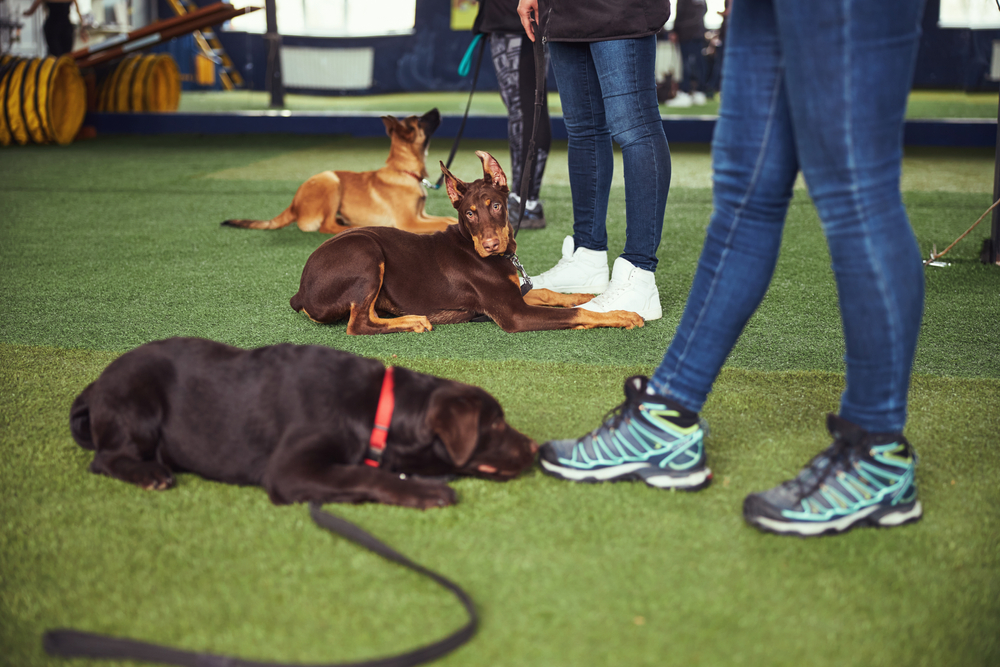When most owners sign up for group classes, their first thought is obedience—commands like sit, stay, and heel. While these skills are important, group training opens the door to something far more valuable: a deeper understanding of your dog. Observing dog behavior in group training reveals things that don’t show up at home or during one-on-one lessons. These sessions become both a classroom for your dog and a crash course for you as the owner.
At Innovative K9 Academy, trainers emphasize that training is as much about the human as the dog. Owners leave group classes with sharper skills, better timing, and a new perspective on their pet’s needs.
Reading Social Cues You Might Miss at Home
Dogs are constantly speaking through body language. In a group setting, where multiple dogs are interacting, these cues become even more visible. Owners often notice for the first time how their dog signals excitement, nervousness, or discomfort. A dog that lowers its ears and tucks its tail during introductions is saying something very different than one that approaches with a wag and relaxed body.
A skilled trainer can help decode these signals, pointing out when a dog is asking for space or when they’re eager to play. This education gives owners a more refined eye for their dog’s moods, making everyday interactions—from dog park visits to meeting neighbors’ pets—more predictable and safe.
Distraction Becomes the Real Test
At home, your dog might sit perfectly when asked, but add a room full of dogs and people, and suddenly the same command feels impossible. Group classes introduce distractions in a controlled, supervised way. Owners see just how much external activity affects their dog’s ability to focus.
Rather than seeing this as a failure, it becomes an opportunity. Trainers guide owners through redirection techniques, teaching them how to regain focus in real-world situations. This skill translates beautifully outside class: walking down a busy street, visiting outdoor cafés, or even hosting family gatherings becomes less stressful when you know how to keep your dog engaged despite distractions.
Building Confidence Through Positive Exposure
Not every dog enters group training with the same level of confidence. Some are bold and outgoing; others are shy or uncertain. In a group environment, these traits become obvious. Owners often discover that their “timid” dog is braver than expected—or that their “fearless” pup actually struggles with certain social situations.
Group classes provide safe exposure to new dogs, people, and environments. Trainers use structured exercises to build a dog’s resilience, and owners get to see the difference firsthand. For nervous dogs, gradual desensitization helps them blossom into more confident companions. For overly confident dogs, learning calm manners prevents pushy behavior.
Spotting Training Gaps and Strengths
Group classes are like shining a spotlight on your dog’s training gaps. Commands that seem flawless at home may crumble in a stimulating group setting. That doesn’t mean the training failed—it means the dog hasn’t yet generalized the skill to different contexts.
Owners quickly learn where reinforcement is needed. For instance, a dog may excel at recall indoors but struggle when surrounded by other dogs. Recognizing these weak points allows owners to focus their practice strategically. Equally important, group classes also highlight strengths, giving owners a chance to celebrate progress and feel proud of their dog’s development.
The Human Side of Training
Group sessions aren’t just about dogs; they train owners, too. Timing, tone, and consistency are crucial, and these classes allow trainers to coach owners directly. You learn when to reward, when to correct, and how to give clear, concise commands.
Owners also discover just how much their dog depends on them for leadership. In moments of uncertainty, dogs look to their humans for direction. Recognizing this builds confidence in the owner, strengthening the relationship between handler and dog.
The Bond That Comes From Teamwork
Perhaps the most meaningful lesson from group training is seeing how much your dog wants to work with you. As owners learn to read their dog’s signals and provide clear guidance, trust grows. This trust forms the foundation of a bond that lasts beyond training sessions.
Many owners report that, after group training, walks feel smoother, home life calmer, and their overall relationship with their dog more rewarding. That bond—based on communication, patience, and consistency—is the real takeaway from group sessions.
Why Group Classes Are Worth It
Enrolling in group sessions isn’t just about teaching commands. It’s about uncovering who your dog is, how they communicate, and how you can support them in becoming their best self. Group environments reveal both challenges and strengths that you might never notice otherwise.
By observing dog behavior in group training, you gain valuable insights that make you a more capable, confident owner. In turn, your dog learns not just obedience, but resilience, social skills, and trust in you as their leader.

